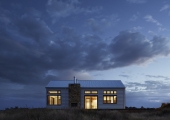July 26, 2013
Report: How will the future affect us or can we effect the future?
Workplace furniture specialist Kinnarps has published its Trend Report 2013, which is the culmination of detailed research across European markets and thought leaders, conducted in partnership with Stockholm based futurologists Kairos Future. The study distilled a broad overview of emerging and established trends, across Kinnarps’ European markets, to focus on eight key themes that will influence the workplace of the future. According to the report, big changes are already apparent in our society, but these will come to have an altogether greater impact on the way we evaluate our working environment.
The eight big changes are:
1. From ‘end-of-line’ to ‘cradle-to-cradle’
There is an ever increasing social conscience about the way our working lives affect the environment and a greater than ever impetus for responsible design. The focus for business now is on the ‘Three Ps’: planet, people and profit. The corporate social responsibility of an organisation is key to its ability to attract and retain good staff. 86% of graduates (according to PWC’s report Millennials at Work, 2011) rate CSR as very important in a potential employer and would consider changing jobs if their employer broke its CSR promises. So, when it comes to furniture design, we can’t just plan our products to the ‘end-of-the-line’, we need to view them in the context of what consultants McDonough Braungart Design Chemistry call ‘cradle-to-cradle’, where people, products and the structural environment are all part of a shared ecosystem, devoid of waste. We need to shift our thinking to consider what will happen to what we leave behind, long after we are gone.
2. From ‘desk bound’ to ‘wireless’
The nine-to-five office job is becoming a thing of the past. We work where we are, whether in the office, the coffee shop, or picking up our emails at home in bed. With mobile phone as the modern answer to the Swiss Army knife – a versatile multi-tool that allows us to adapt to our environment – companies of the future will need to manage workers remotely, yet allow them to collaborate with colleagues no matter where they happen to be. Digital technology is now so entrenched in our thinking that in 2012 the UN included access to the internet in its list of basic human rights. A workplace that champions speed, flexibility and trust will demand a new generation of leaders.
3. From ‘bronze’ to ‘silver’ society
Standard retirement age is consigned to the past, with people both needing and wanting to work longer. According to Derek Barker, MD, designer and architect at Haskoll UK: ‘It’s about utilising their skills and experience. The experience of the 1940s baby boomers generation provides support to the younger generation, while Generation Y can convey a sense of being ‘cool, connected and on-line’ to their older colleagues. The mixture has a positive effect on the whole company.’ Smarter companies will opt for working environments that allow the generations to mix and create symbiosis. However, there will be new challenges in achieving office spaces that are flexible enough to accommodate their varying, and sometimes conflicting, needs.
4. From ‘surface design’ to ‘design thinking ‘
Designing the workspace won’t just be about making it look attractive. Smart design will incorporate wellbeing and motivation into the fabric of the working environment. For decades, employers have acknowledged that the workplace has an important role to play in optimising performance, but now the working landscape (and the demographic of its workers) is changing apace and organisations need to adapt their design strategy to cope.
5. From ‘hard cash’ to ‘soft values’
It isn’t all just ‘show me the money’ anymore. Soft values, such as appreciation, dedication and the ability to exert influence increasingly contribute to our happiness at work. According to Thomas FÜrth, research director at Kairos Future, ‘Things which are important to employees are also important to employers. An employee who feels good is more loyal and engaged, which is an obvious economic advantage for the employer.’
6. From ‘solitude’ to ‘multitude’
As home lives become increasingly solitary, the workplace will rise in importance as a place of social interaction and collaboration. Smart offices of the future will be flexible, agile spaces that encourage workers to come together to share knowledge and inspire creativity.
7. From ‘concentration’ to ‘distraction’
In creating collaborative workspaces, it is important to remember that we sometimes think best when we are allowed to concentrate. This is certainly borne out by the increasing trend of ‘working from home’ when people need to focus without distraction. The office of the future will provide workers with spaces to collaborate, contemplate or concentrate as the task in hand demands.
8. From ‘workstation’ to ‘freewheeling environment’
New technology and new ways of thinking and working lead to employees abandoning their fixed workstation. We no longer sit in one place, repeating a series of tasks, so the workplace of the future needs to provide areas designed to house a variety of activities as well as smaller, traditional office spaces.
To request a free copy of the full Kinnarps Trend Report 2013 click here:













